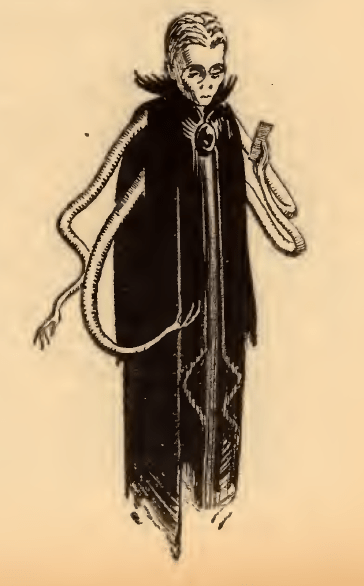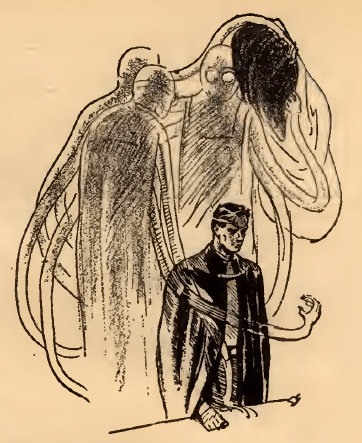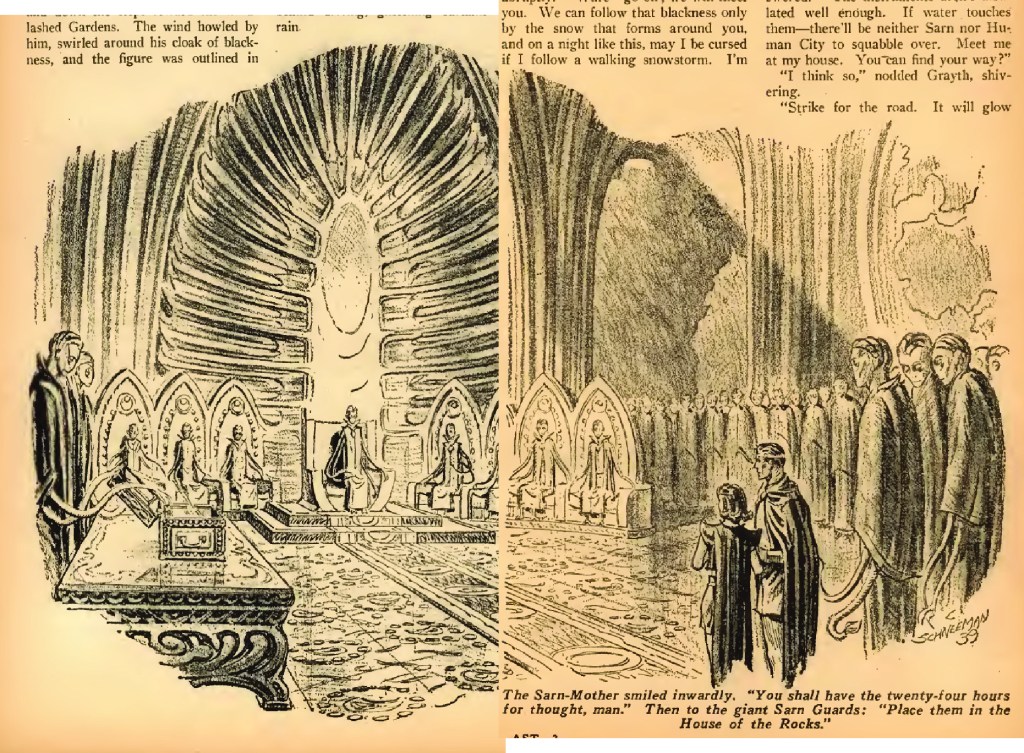This is the last of my daily run of blog posts for now, marking the 30th post in a row! Most of them have been on invisibility in fiction, and we wrap with a fascinating example. I’ve still got more invisibility to post, but I won’t try to do them every day…
Is there a word for finding the correct thing by mistake? That is basically what happened with the next story of invisibility to discuss, “Cloak of Aesir,” by Don A. Stuart, published in the March 1939 issue of Astounding Science-Fiction.
So why was I mistaken? Well, here’s the description of “Cloak of Aesir” from the table of contents:
A man and the Sarn-Mother and a cloak of blackness— and the old Sarn-Mothcr couldn’t hate that human enemy!
The description of the “cloak of blackness” is what caught my attention, as it certainly sounds like something invisible-y! In the story, however, the cloak is easy to spot in most circumstances, as long as there is light around. Nevertheless, the story also includes invisibility devices, so I found an invisibility story for the wrong reason!
But this story is special for another reason: it uses some physics to explain the “Cloak of Aesir” that I’ve never seen in a science fiction story before! So let’s take a look. Significant spoilers ahead, so if you want you can read the story in advance.
The novelette is set in Earth’s far future, 4000 years after an alien race, the Sarn, have conquered and subjugated humanity. They are not cruel in their rule, but humanity has no freedom whatsoever, and any attempt to go against the Sarn is met with quick and deadly force.
But as the story begins, the Sarn-Mother — a literally immortal being who has been alive longer than any can remember — is concerned. A new slow and mysterious revolt has been brewing among the humans, which would be concern enough, but the humans have a powerful ally: a being known as Aesir, who appears in the depths of the Sarn stronghold to rescue two humans who have just been sentenced to death:
“Then—Aesir, he called himself—appeared. He was a blackness—a three-dimensional shadow. He stood some four feet taller than I, nearly twelve feet tall, twice the height of humans. But he was shaped like a human in bulk, though the vague blackness made any feature impossible. He claimed that he was not made of any form of matter, but was the crystallization of the wills of all humans who have died in any age, while seeking freedom.
Aesir speaks to the Sarn-Mother using telepathy, revealing that humans have developed this power, something the Sarn do not have:
“Aesir spoke by telepathy. Mind to mind. We know the humans had been near that before the Conquest, and that our own minds are not so adapted to that as are the humans’. Aesir used that method.”
The Sarn-Mother attempts to destroy Aesir with the most powerful weapons in her arsenal, none of which have any effect. The two human prisoners, Grayth and Bartell, are allowed to leave, simply because the risk of further opposing Aesir is too great, in terms of life and resources.
But the Sarn-Mother has a plan to gain more information about Aesir and his cloak of blackness. She orders the recapture of Grayth and his love Deya; they will be used to lure Aesir back to the Sarn stronghold, where sensors will be ready to test Aesir’s cloak and learn its secret. To perform the abduction, the Sarn break out one of their most closely held secrets: invisibility!
The case, opened, revealed a space two by three by one-half foot. In it, racked neatly along one side, were twenty little battery cases, with coiled, flexible cables attached, and twenty headsets, bearing curiously complex goggles.
The case was practically empty. The Decalon reached in, and with practiced movements passed to her command the goggles and battery cases. Then she reached more carefully into the body of the case. The reaching hand vanished. Presently, queerly section by section, the Decalon was wiped out, till only a pair of feet remained, dwindling off into space. These vanished as some unseen boots were pulled over them.
The Sarn agents use these invisibility cloaks to abduct Grayth and Deya without raising an alarm. They also envelop the pair in invisibility devices in order to steal them away.
How is this invisibility achieved? It is explained, telepathically, by the human scientist Ware:
Then Ware’s calm mind obtruded powerfully, silently. “The blackness is not related to mine. It is caused, I suspect, by the complete refraction of light about your body. To be invisible, you must be rendered blind to visible light, since any organ capable of seeing must, by its nature, intercept light. Struggle slightly. Strike the face of one of the Guard.”
But if the wearers of the invisibility cloaks cannot see visible light, how do they get around? Ware explains this as well:
“Goggles,” said Ware softly. “Transformers, probably, operating on ultravisible light, thus making vision possible with invisibility.”
So there is not a lot of technical detail, but the mechanism of invisibility is the “cloaking” variety, in which light is guided around the hidden being or object.
Who is this scientist Ware? He is the Aesir, wearing a cloak of advanced technology that he built. His explanation of the cloak is where I really stood up and paid attention to the story:
“Dirac, a physicist of the pre-Sarn days, explained the positron as a hole in a continuum of electrons in negative energy states. Space, he said, was completely filled with electrons possessed of negative energies. It was full to the brim, and overflowed into the electrons we can detect—ordinary matter electrons.
In the early 1900s, two new theories began to form that would revolutionize physics: the special theory of relativity, which described the motion of objects at high relative speeds, and quantum mechanics, which described the wavelike properties of matter on the scale of the smallest particles. These two theories really developed in parallel, and thus quantum mechanics was initially developed without Einstein’s special theory of relativity.
In 1928, the English physicist Paul Dirac made the first attempt to bring these two theories together, and published what is now known as the Dirac equation, a relativistic wave equation. A curious and unexpected consequence of this derivation is that solutions effectively come in groups of four: two positive energy solutions and two negative energy solutions.
The fact that there are two positive energy solutions (and two negative) was interpreted as representing the two quantum spin states of the particle. The negative energy solutions were much more of a challenge to explain. As time passes, particles tend to drop into the lowest energy state available to them (a gross oversimplification, but this is a blog post). The existence of an infinite number of negative energy states seemed to imply that every electron should quickly decay into increasingly negative energy states.
To get around this, Dirac suggested that all of the negative energy states are occupied by electrons. Because no two electrons can occupy the same state (the Pauli exclusion principle), then electrons cannot drop below zero energy. These negative energy electrons were proposed to be unable to be observed, but if one of those negative energy electrons were to be kicked up to positive energy, the “hole” it left behind would look like a positively-charged electron. In this scenario, some sort of interaction would cause the creation of a positive electron and a negative electron at the same time.
What Dirac had basically predicted is the existence of antimatter, and this positively-charged electron, the positron, was discovered in 1932.
Today, we no longer believe in this “sea” of negative energy electrons, and it is possible to reformulate Dirac’s theory in terms of positive energy particles and antiparticles. The idea of “holes” turns out to be relevant in condensed matter physics: electrons knocked free of their positions leave positively charged “holes” that act as particles themselves.
But “Cloak of Aesir” takes Dirac’s idea and runs with it, to delightful effect! Ware has discovered a way to harness the “negative energy” of the electron sea, and with that infinite well of negative energy, his cloak can absorb any attack launched against it. It is also a cloak of darkness, of course, because it absorbs all light hitting it, and anyone who touches the outside of the cloak is killed instantly. Or as Ware describes it:
“Shortly before the Sam came, men were developing hints that there might be more to that. There was. Electrons in positive energy states, when vibrated, gave off radiation—light, heat, and so on. If you use energy concentrated enough, you can vibrate electrons in negative energy states. You might say they give off negative energy radiation. They produce photons of energy in negative energy states.
“As I said, it’s an analogy that I can’t honestly describe, but the effect is radiated negative energy. Radiant cold or radiant darkness or radiant lack-of-X-rays—whatever you want.
“Energy being conserved, of course, the result is that the source of that radiation. instead of consuming energy, gives it off. My pack does not radiate negative energy; it sets up a condition in the air about me that makes the air atoms radiate negative energy.
Of course, none of this is really how any of the physics works, but it is an absolutely delight to see Dirac’s idea converted into a science fiction technology. I’m sure that there are other stories that use Dirac’s sea, but this is the first one I have personally encountered.
From the description of Ward and his alter-ego Aesir, you can tell that “Cloak of Aesir” is basically a science-fiction superhero story. In the end, though, it is not the Cloak of Aesir that defeats the Sarn: it is an entirely different form of negative energy, employing the human-only power of telepathy:
“Down, Simons,” said Dr. Wesson’s voice. There was a gentle urgency in it, a pitying yet firm tenderness. A pair of feet appeared, slowly, wearily, with an air of terrible, unending exhaustion —tired beyond all rest, misery and hopelessness subtly expressed in the dull, shambling descent of those heavy feet.
Loosely, miserably they came down the long flight, their mechanical, rhythmic drumming a muffled beat of defeat. The man came into view. His figure was lax, powerfully muscled arms and shoulders bent under a soul-deadening weight of overwhelming despair. Down—down— “Down, Simons.” The doctor’s voice was weary with a queer despair caught somehow from that doom-weighted figure.
Ware turned slowly to look at Deya, at Grayth. “Who is he—Simons?”
It is Deya who came up with this plan to drive the Sarn from the Earth:
“That is negative energy, Ware. That is the negative energy of the mind, the blackness of Aesir applied to all hope, all ambition. He is mad ; he is a maniac depressive. He has no hope, no thought of escape from that negative hell of despair that is beyond despair. He is mad, for no sane mind could conceive that awful blackness, the hopelessness that is a positive, devouring force that infests his being.
“If ever his mind should start to mend, he will become a suicidal maniac, driven to kill himself in any way he can, at any horrible expense. He cannot think of that escape now. That is struggle, that is in itself a hope—and he has none. To conceive of death as an escape is to hope, to believe that something better can be.
…
“Record his thoughts. Record them there on that silver ribbon. Record that hopelessness that knows no resistance, no will to struggle. Record it, and broadcast that through the Sarn City!”
The plan is carried out. And, over time, the will of the Sarn, to whom this message of despair is exclusively being broadcast, is broken, and they voluntarily leave the Earth. It is not a bad ending for them, however, as they gain peace in returning to their homeworld:
For the first time in four thousand years she was leaving her city. For the first time in four thousand years no Sarn remained in Sam City. The clouds and gloom were suddenly below, a dull grayness that heaved and writhed like a living dome over Sarn City. June sunlight angled from the setting redness in the west across the Human City stirring vaguely there below. A warmth she had not known in six unending days shot through her ancient body, and a blissfulness of sleep lapped her as the ship accelerated strongly, confidently, toward the sparkling waters beyond, toward Bish-Waln, bright and hot in the golden Sahara.
The idea of exploiting someone who is mentally ill as a weapon against an enemy should be terribly offensive to me, as someone who has — and still is — struggling with severe depression. However, the thought of being able to put that despair and hopelessness to a positive end is somehow reassuring to me.
“Cloak of Aesir,” though not what I was originally looking for in a story, turned out to be a fascinating tale not only of invisibility but of other classic physics.
Okay, and this marks the end of my 30-day run of blog posts, mostly about invisibility in fiction! I hope you’ve enjoyed this looks at stories that probably nobody has read in fifty years, many of which are quite enjoyable. I will still be blogging, of course, but am returning to a more mellow pace of posting.







Very clever piece of sci-fi! It boggles my mind that there is so much out there I’ve never read or even heard of…
Me, too!
“Is there a word for finding the correct thing by mistake?” – how about “serendipity”? The OED says it is the faculty of making happy and unexpected discoveries by accident. It has a curious etymology.
I had thought that, but I usually associate “serendipity” with “finding something that you weren’t looking for.”
I’ve read this one! I think it was in a collection of science-fiction stories all published in 1939, also including Eando Binder’s “I, Robot”.
(Milkshake duck warning) “Don A. Stuart” was the pen name of the magazine’s editor, John Campbell, who was amazingly racist and also kick-started Scientology by printing Hubbard’s first article on “Dianetics”.
The anime Neon Genesis Evangelion also has something that it calls a “sea of Dirac”, a kind of … infinitesimally thin layer of nonbeing that one can fall into and be trapped inside, existing in a purgatory of sorts. The whole show is full of scientific and religious terminology shoved in every which way, and it’s never spelled out how much is meant to be literal versus codenames (like “Trinity test”). And a lot of it sure seems to be about the creator being depressed. It’s the kind of story that, like Watchmen, takes the tropes of a genre and plays them absolutely straight in order to portray exactly how damaged everyone in that situation would have to be.
I’ve been really enjoying these posts — catching up on them in batches — but this was the first one I realized I had anything to say about.
Good to hear from you!
We just submitted a grant proposal to the NSF today, so I might even have time again to talk about things.
Reblogged this on Skulls in the Stars and commented:
Let’s do another reblog of an invisibility story! Still on a blitz to make sure everyone knows about my book on the history and science of invisibility.